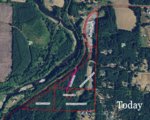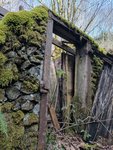



Many longtime Lewis County residents remember the Bunker Landfill fondly. Almost in a nostalgic way, if that’s possible for a forgotten garbage dump.
Over half of the people I’ve talked with about the old dump have memories of shooting rats at the old dump site. Or, rides with dad or grandpa to the site. Some remembered “Boots,” the little old man who lived in the shack at the top of the landfill. Others didn’t recall the dump or landfill, but remembered the “drop box” that was built at the site, after the landfill was condemned by the Washington State Department of Ecology in the 1970s.
My last column on this topic examined a possible connection between local instances of cancer and excessive nitrates in groundwater, potentially affecting private wells. But, could this old dump, consigned to oblivion, be affecting public health now?
According to the results of a public records request to the county, you’d never know the Bunker Landfill site ever existed. The site predates the regulations that require records for landfill sites.
Inquiries to DOE produced the same result — it was like the landfill never existed.
But it did exist. It was an unlined landfill, just past Spooner Road, headed west out state Route 6 on the left. The old driveway can still be seen, if you look close. Bunker dump was one of the largest in the county. In the 1970s, officials estimated that 70 percent of the waste dumped at the west Lewis County site was coming from city folks dodging “tipping fees” (dump fees) at the Centralia landfill.
Over the past few weeks, I’ve been working with DOE officials to make sure the site is added to the state’s Closed / Abandoned Landfill program so that it can be properly evaluated and monitored, if necessary.
Some of the information that follows is what I have turned up through The Chronicle archives, Chehalis Bee Nugget archives, and conversations with longtime community members.
In the 1930s, state legislation passed that made garbage dumping on the sides of roads and highways illegal. Despite the new law, garbage dumping on roads in Lewis County remained a persistent problem, as evidenced by news briefs in The Chronicle.
After higher fines and stiffer penalties failed to adequately curb the problem, local elected officials scheduled free dump and disposal days at informal dump sites around the county. This became so successful that, in the 1950s, citizen panels recommended that wider use of the community dump sites should be adopted.
It could be said that the county inadvertently ended up in the garbage business.
When the dump was full, the garbage was burned. This was monitored by caretakers (like Boots), and then the remaining burned material would be buried into the ground, layer upon layer, to make room for more garbage.
When rats infested the dump, they were routinely poisoned (one poisoning event at the Toledo dump resulted in 3,000 dead rats, according to news archives). Target shooting of rats at the dump was also reportedly encouraged — and apparently a popular activity.
By the 1950s, the Bunker dump site is mentioned in The Chronicle as an established dumping site. The site would continue to serve the Adna area until the late 1970s, when the countywide drop box program was implemented.
Previous coverage from The Chronicle states: “The usual process in closing a dump is to poison the rats, cover the dump with fill, fence it off and reclaim it by planting grass seed … ”
As far as anyone knows, decades of burned up garbage are still buried in the Spooner Road hillside.
A lot has been learned about landfills, soil and groundwater contamination since the 1950s. The Bunker site was condemned by the Department of Ecology, along with more than a dozen other similar sites in the county, as new ecological regulations took effect in the 1970s.
Essentially, at the time, the county knew that their landfills couldn’t meet the new standards (standards requiring liners, etc.), so they closed their open pit dumps and constructed “drop boxes” at the sites (or nearby), where waste was then transferred off-site by truck to the Centralia landfill to meet new regulations regarding sanitation.
The Centralia landfill was an EPA superfund site in the 1990s, due to concerns regarding groundwater contamination from leached metals and other contaminants, which eventually led to the construction of the current Centralia Transfer Station.
The Bunker landfill site is just 1,000 feet uphill from the Chehalis River and located within an aquifer recharge zone, meaning that water is known to move through the soil to the groundwater at that location. In fact, there’s a creek that runs either through or just next to the old landfill site, directly into the Chehalis River, which serves as a residential water source.
Looking at current DNR LIDAR maps of the old landfill site, it appears obvious that the hillside has sloughed downhill overtime. In fact, the old landfill site is just above the stretch of state Route 6 that has been repaired by WSDOT multiple times, where the road persistently becomes uneven, near the adjacent railroad tracks.
I wonder if WSDOT knew they were working directly below a landfill? I haven’t found any evidence that they did.
While looking at public records for Boistfort Valley Water (BVW), I noticed that water quality tests indicated a significant rise in iron and manganese levels in the late 1970s. According to DOE, it’s not uncommon for leaching landfill waste, known as leachate, to result in elevated iron and manganese levels in groundwater. Other volatile organic compounds (VOC) were present at state reporting levels in past BVW test results on file.
Boistfort Valley Water constructed their Chehalis River surface water uptake source on the Chehalis River, roughly across the river from Adna Grocery, in the late 1970s, around when higher levels began to be detected — just 1.7 miles upstream from the Bunker landfill, as the crow flies.
The county also had its final garbage burning permits extended in the mid-1970s, as it worked toward the completion of the new county-wide drop box transfer system.
Could the iron and manganese levels and the landfill be connected somehow?
I reviewed Department of Ecology’s early 1990s “Total Maximum Daily Load” (TMDL) study for the Upper Chehalis River, which detailed potential pollutant sources on the Chehalis River. The study specifically notes:
“Thus, the evidence suggests that a pollutant source above the Claquato bridge and below the Ceres Road bridge (where no dissolved oxygen problems were found in October 1991) was a contributing cause of the low dissolved oxygen in the Centralia reach. The nature of the upstream source is unknown, but several facts may be relevant.”
The study goes on to list agriculture and other sources as possibilities for the origin of the unknown source — but the Bunker landfill site is below Ceres Hill bridge on the river, and above Claquato bridge.
What if the undocumented Bunker landfill, unknown to DOE officials, was contributing to the dissolved oxygen issues all along?
Officials with Lewis County were well aware that records for the landfill did not exist. There is some mention of having the depth and width of the landfill examined in a 2004 ecological survey on the parcel, but it doesn’t appear that’s ever been done. That particular 2004 study also notes that the site is particularly vulnerable to groundwater contamination because of the mining activities that have occurred on the site previously.
Interestingly, there are permits pre-dating the landfill, associated with the parcel, for mining activities and other things, but the garbage burning variance permits from the Southwest Air Pollution Control Authority mentioned in The Chronicle’s 1970s coverage didn’t turn up in the county records request.
There are also no water quality tests on file with the county for the parcel where the Bunker landfill was located.
Considering that the unlined landfill is located uphill from and so close to the river, in an aquifer recharge zone, close to residential private wells and near public water system uptakes, coupled with the overall concern regarding public health and lack of previous examination, it seemed ample reason to ask DOE to look into the site.
On March 22, the Bunker landfill was assigned a number for the first time ever — an Environmental Reporting System Tracking (ERTS) number, which means DOE has accepted my report and has 90 days to complete a cursory investigation of the site. As of the publishing of this column, the landfill is in the “Initial Investigation (II)” stage.
As my favorite DOE media contact, Dave Bennett, would say:
“There’s something to be said for environmental justice here.”
•••
Brittany Voie is senior media developer for The Chronicle. Watch for updates as the investigation into the undocumented Bunker landfill site progresses. If you have a memory of the Bunker dump, send it to bvoie@chronline.com.